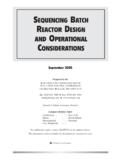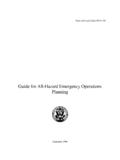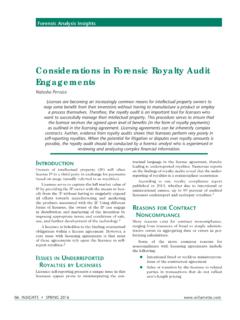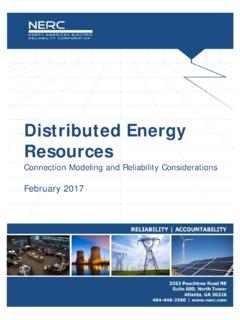Transcription of HCMOS Design Considerations (Rev. A) - TI.com
1 HCMOS Design Considerations SCLA007A. September 2002. 1. IMPORTANT NOTICE. Texas Instruments Incorporated and its subsidiaries (TI) reserve the right to make corrections, modifications, enhancements, improvements, and other changes to its products and services at any time and to discontinue any product or service without notice. Customers should obtain the latest relevant information before placing orders and should verify that such information is current and complete. All products are sold subject to TI's terms and conditions of sale supplied at the time of order acknowledgment. TI warrants performance of its hardware products to the specifications applicable at the time of sale in accordance with TI's standard warranty.
2 Testing and other quality control techniques are used to the extent TI deems necessary to support this warranty. Except where mandated by government requirements, testing of all parameters of each product is not necessarily performed. TI assumes no liability for applications assistance or customer product Design . Customers are responsible for their products and applications using TI components. To minimize the risks associated with customer products and applications, customers should provide adequate Design and operating safeguards. TI does not warrant or represent that any license, either express or implied, is granted under any TI patent right, copyright, mask work right, or other TI intellectual property right relating to any combination, machine, or process in which TI products or services are used.
3 Information published by TI regarding third party products or services does not constitute a license from TI. to use such products or services or a warranty or endorsement thereof. Use of such information may require a license from a third party under the patents or other intellectual property of the third party, or a license from TI under the patents or other intellectual property of TI. Reproduction of information in TI data books or data sheets is permissible only if reproduction is without alteration and is accompanied by all associated warranties, conditions, limitations, and notices. Reproduction of this information with alteration is an unfair and deceptive business practice.
4 TI is not responsible or liable for such altered documentation. Resale of TI products or services with statements different from or beyond the parameters stated by TI for that product or service voids all express and any implied warranties for the associated TI product or service and is an unfair and deceptive business practice. TI is not responsible or liable for any such statements. Mailing Address: Texas Instruments Post Office Box 655303. Dallas, Texas 75265. Copyright 2002, Texas Instruments Incorporated 2. Contents Title Page Introduction .. 1. HCMOS Designer's Information .. 1. CMOS Circuitry .. 1. High-Speed CMOS Characteristics.
5 5. Protection Circuitry .. 8. ESD Protection .. 8. Latch-Up Protection .. 9. Fan-Out and Capacitance Loading Effects .. 11. Power Dissipation .. 13. HCT Power Dissipation .. 13. Power-Supply Decoupling .. 14. Decoupling Procedure .. 14. Connecting Unused Inputs .. 15. Matching .. 15. Powering-Up/Down Sequence for High-Speed CMOS .. 15. High-Speed CMOS Interfacing .. 16. Introduction .. 16. General Interfacing Solution .. 16. Noise Margin .. 17. Driving-Gate Output Model .. 17. Input-Gate Circuit .. 18. CMOS-to-Standard-TTL Interface .. 18. Standard TTL-to-CMOS Interface .. 19. CMOS-to-LS Interface .. 21. LS-to-CMOS Interface.
6 21. CMOS-to-ALS Interface .. 22. ALS-to-CMOS Interface .. 22. CMOS-to-AS Interface .. 23. AS-to-CMOS Interface .. 23. CMOS-to-NMOS Interface .. 24. NMOS-to-CMOS Interface .. 24. Using HCT Devices to Interface with CMOS From TTL .. 24. Oscillators .. 25. RC Oscillators .. 25. Crystal-Controlled Oscillators .. 25. Voltage-Controlled Oscillators .. 25. Drivers for LEDs and Relays .. 27. Introduction .. 27. Driving LEDs .. 27. Driving Relays .. 27. iii Contents (continued). Title Page SN54/74HC Interchangeability Guide .. 28. Introduction .. 28. TTL: Transistor-Transistor Logic .. 28. 4000 Series: Metal-Gate CMOS Logic.
7 28. Interchangeability Considerations .. 28. LS .. 28. Other TTL Families .. 28. 4000 Series .. 29. Electrostatic Discharge (ESD) .. 30. Introduction .. 30. What is ESD and How Does It Occur? .. 30. Latent Defects .. 30. What Voltage Levels of ESD Are Possible? .. 30. How to Avoid ESD Damage to ICs .. 30. Humidity .. 31. Training .. 31. ESD Specification .. 31. ESD Coordinator .. 32. Audits .. 32. TI ESD Handling Procedure .. 32. Moisture Sensitivity of Plastic Surface-Mount Packages .. 33. Conclusion .. 34. iv List of Illustrations Figure Title Page 1 Inverters .. 1. 2 Transmission Gates .. 1. 3 Gates .. 2. 4 Exclusive-OR/NOR Gates.
8 3. 5 Inverting 3-State Output Buffer With Active-Low Enable .. 3. 6 Transparent Latches .. 4. 7 Negative-Edge-Triggered D-Type Flip-Flops .. 4. 8 Simplification of Diagrams by Combining Inverters .. 5. 9 Power Consumed vs Frequency for High-Speed CMOS Compared to LS .. 6. 10 Typical Distribution of Switching Frequencies for Gates Within a System With Maximum Clock Frequency, fs .. 6. 11 Contribution to Total Power by Gates Running at Frequencies From 0 to fs .. 6. 12 High-Speed CMOS and LS Noise Margins .. 7. 13 ESD Input Protection Circuitry .. 8. 14 ESD Output Protection Circuitry .. 9. 15 Parasitic Bipolar Transistors in CMOS.
9 9. 16 Schematic of Parasitic SCR With P-Gate and N-Gate Electrodes Connected .. 10. 17 Unique Latch-Up Suppression Utilizes Guard Rings to Virtually Eliminate Latch-Up .. 10. 18 Worst-Case Output and Input Circuits of High-Speed CMOS .. 11. 19 Gate Output Buffer .. 14. 20 Test Circuit for Decoupling Effects .. 14. 21 VCC Transients vs Decoupling Capacitor Distance From DIP .. 15. 22 Voltage Transfer Characteristic of a Typical Inverter .. 16. 23 Noise Margins .. 17. 24 Output Model of a Driving Gate .. 18. 25 SN54/74HC Input Gate .. 18. 26 SN54/74HC-to-TTL Interface .. 19. 27 TTL-to-SN54/74HC Interface With a Pullup Resistor.
10 19. 28 SN54/74HC-to-LS Interface .. 21. 29 LS-to-SN54/74HC Interface With a Pullup Resistor .. 21. 30 SN54/74HC-to-ALS Interface .. 22. 31 Interface With a Pullup Resistor .. 22. 32 SN54/74HC-to-AS Interface .. 23. 33 AS-to-SN54/74HC Interface With a Pullup Resistor .. 23. 34 Simple RC Oscillator Using Two HC04 Gates .. 25. v List of Illustrations (continued). Figure Title Page 35 Oscillator Circuit Using a Crystal to Set the Period .. 25. 36 VCO .. 26. 37 HC04 Driving an LED .. 27. 38 SN54/74HC04 Gates Connected in Parallel to Drive a Relay .. 27. 39 ESD-Protected Workstation (Side View) .. 32. Tables Table Title Page 1 Performance Comparison of High-Speed CMOS With Several Other Logic Families.
















